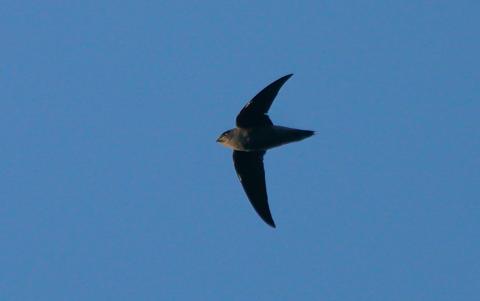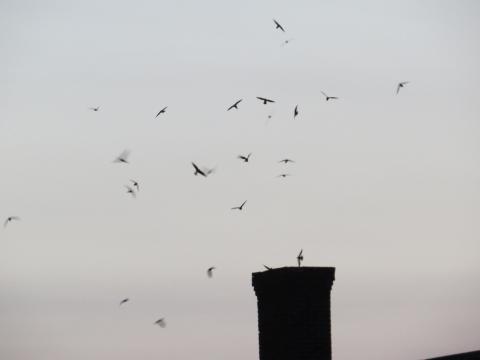Up In The Air
Chimney Swifts are a common sight in most of New Hampshire’s towns and cities, and occasionally show up far from human habitation. Commonly described as “cigars with wings,” swifts are small brown birds roughly 5” long that fly with rapid stiff wingbeats. They are uncontested masters of the air, and only stop flying to nest and sleep (some swift species are even known to sleep on the wing). When they do land, they cannot perch like most other birds, and instead cling to vertical surfaces using their tails as a brace.

A chimney swift in flight. Photo by Ed Norton.
As their name implies, Chimney Swifts are strongly associated with chimneys, which are used for nesting and for evening roosting. Prior to European colonization they used large hollow trees, but were already recorded nesting in chimneys by 1672, and now use man-made structures almost exclusively. Nests are made of small twigs (collected in flight from dead branches!) glued together – and to a vertical surface – using the swift’s viscous saliva. Four or five eggs are laid in early June and hatch about three weeks later. In another three weeks the young are ready to fly.
Chimneys are important outside of nesting as well, and during the non-breeding period swifts gather for the night in large communal roosts that can host thousands of birds. Here in New Hampshire, the largest roosts (100+ swifts) occur in May and August. After foraging all day, the birds gather toward dusk near their chosen chimney and make large circuits of the sky overhead. Then, as the light dims, they start to enter the chimney in a swirling mass that resembles a small twittering tornado. The same chimneys are often used several years in a row, and in some cases have become local tourist attractions! [e.g., https://www.prestonmnchamber.com/play/attractions/chimney-swift/ and https://www.roadsideamerica.com/tip/963]

Chimney swifts are strongly associated with chimneys, which are used for nesting and for evening roosting. Photo by Becky Suomala.
But Chimney Swifts are in trouble. Throughout their range, populations have been steadily declining since at least the mid-1960s, and in New Hampshire they are less than half as common as they were 50 years ago. Similar or larger declines are also being seen in the ecologically-similar swallows (both swifts and swallows capture insects on the wing), and scientists are only just starting to tease apart possible threats.
Because they now nest predominately in chimneys, swifts are potentially affected by any alterations made to these structures. Capping a chimney that is no longer used makes it inaccessible for nesting, and metal or ceramic chimney liners cannot support the birds’ nests. At the same time, shifts in home heating options have resulted in fewer suitable chimneys being built in the first place. The good news here is that studies in Connecticut and Canada have determined that there are still plenty of suitable chimneys around - they’re just not being used by swifts. This would imply that nesting chimneys are NOT what’s limiting swift populations, and that we need to look elsewhere for the more important threats.
But what about roosting chimneys? The largest are associated with old factories and similar commercial buildings. As manufacturing has declined, many of these large old chimneys are being taken down, often because they are deteriorating and at risk of falling apart. When a long-term roost site of this sort is lost, we’re not sure what happens to the swifts that use it, but we presume they manage to find suitable alternatives. The costs of using “unsuitable” roost sites are essentially unknown, but we know they’re important at cooler temperatures, when swifts huddle together to keep warm.
The potential loss of nesting or roosting chimneys has resulted in efforts to provide artificial structures in the form of “swift towers.” These tall hollow wooden structures have been used by swifts in southern states, but despite considerable effort have not been occupied in the Northeast, Midwest, or Canada. The suspicion is that swift towers simply lack the thermal characteristics of chimneys or hollow trees, and thus don’t stay warm enough at night.
Even if changes in chimneys aren’t a significant threat to New Hampshire’s Chimney Swifts, keeping such nesting sites available is important. Swifts still need a place to nest, and providing one can make their lives easier in the face of whatever other threats are out there. If you have an unlined masonry chimney, leaving it uncapped is a good first step – or consider removing the cap if one is already present. Have your chimney cleaned outside of the breeding season so as not to disturb any birds that may be nesting there. And if you hear bird noises through your walls, take joy in the fact that you are providing a home for a declining species. You might also consider closing your chimney damper or taking other precautions against young swifts accidentally going down the chimney and into your living room.
Another possible threat to Chimney Swifts is a change in food supply. They feed entirely on small flying insects, including flies, bees, bugs, and beetles, and there is increasing evidence that insect populations are in decline. Studies of swift guano from roosts discovered diet shifts 40 years, with a decline in beetles corresponding to years of DDT use. And even though DDT has been banned for decades (but not in South America!), there are other pesticides and land-use practices that could easily impact swifts’ prey. Studies on swallows have mixed results in this regard: some showing lower reproductive success in heavily agricultural landscapes and others not. There is still much to learn about the factors that influence swift nesting success.
Finally, no overview of a migratory bird is complete without some consideration of events outside the breeding season. Chimney Swifts are long-distance migrants that winter in northern South America, and any of the threats discussed so far (loss of chimneys, insect declines) can affect them anywhere along their route. There are also risks associated with climate change: increased storms leading to high mortality during migration or sudden cold snaps suppressing flying insects. There are fewer things we in New Hampshire can do to directly aid swifts when they’re not here, but it remains important to understand that full annual cycle conservation is critical if we’re to help swifts and other migrants recover (so think about your chimney next spring!).
More information is available at chimneyswifts.org.
Fall 2021 Taking Action for Wildlife Newsletter


